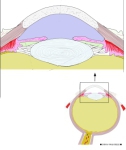
・「房水は眼科学会の慣用語で、眼房水は解剖学会の慣用語」(日本人体解剖学)



房水の詳しい組成に関しては下の「Wikipedia」の解説を参照のこと。

|
 |
|
|
前眼房 |
眼房 |
眼球・横断面 |
眼球・縦断面 |
「 船戸和弥のHP 」では以下のように解説している。
「眼房水は単に房水ともいい、毛様体上皮より分泌される弱アルカリ性の漿液。小帯隙、後および前眼房を潤したのち、虹彩角膜角隙を経て強膜静脈洞に流入する。主に前毛様体静脈に吸収されると推定される。」
また、「Rauber-Kopsh解剖」では以下のように解説している。
「眼球の前方部にはまず前眼房Camera oculi anteriorがあり,そのほか角膜と強膜のこれに接する部分とには液細管Saftkandilchenがある.
前眼房は水様液Humor aqueus, Kammerwasser(眼房水)とよばれる水の様な透明の液体でみたされている.この液はごく少量の蛋白質および糖とわずかの白血球をふくみ,液の量は0.2~0.3gである.前眼房は毛細管のように狭い虹彩水晶体間隙Iris-Linsenspalteによって後眼房につづき,後眼房はまた小帯隙Spatium apparatus suspensoriiとつづいている.
水様液は後眼房において毛様体と虹彩の脈管から産出される.そしてここから前眼房へ流れ,さらに虹彩角膜角海綿質Spongium anguli iridocornealisのすきまから強膜静脈洞Sinus venosus scleraeをへて毛様体静脈Vv. ciliaresにはいる.角膜の方へ液が流れ去ることはないか,あるとしても微々たるものにすぎない.角膜の栄養も水様液から行われるのではなく,角膜を輪状にとりまく角膜辺縁係蹄網Randschlingennetz der Hornhautから供給されるのである.」
そして以下は「Wikipedia」の解説文となる。
The aqueous humour is a transparent water-like fluid similar to plasma, but containing low protein concentrations. It is secreted from the ciliary body, a structure supporting the lens of the eyeball. It fills both the anterior and the posterior chambers of the eye, and is not to be confused with the vitreous humour, which is located in the space between the lens and the retina, also known as the posterior cavity or vitreous chamber.Blood cannot normally enter the eyeball.
【 語 句 】
・transparent:透明な ・plasma:血漿 ・protein concentrations:タンパク質濃度 ・secrete:分泌する ・ciliary body:毛様体 ・vitreous humour:硝子体液 ・retina:網膜
【Composition】
- Maintains the intraocular pressure and inflates the globe of the eye. It is this hydrostatic pressure that keeps the eyeball in a roughly spherical shape and keeps the walls of the eyeball taut.
- Provides nutrition (e.g. amino acids and glucose) for the avascular ocular tissues; posterior cornea, trabecular meshwork, lens, and anterior vitreous.
- May serve to transport ascorbate in the anterior segment to act as an antioxidant agent.
- Presence of immunoglobulins indicates a role in immune response to defend against pathogens.
- Provides inflation for expansion of the cornea and thus increased protection against dust, wind, pollen grains, and some pathogens.
- For refractive index.
- Prevents eye dryness.
【Production】
Aqueous humour is secreted into the posterior chamber by the ciliary body, specifically the non-pigmented epithelium of the ciliary body (pars plicata). 5 alpha-dihydrocortisol, an enzyme inhibited by 5-alpha reductase inhibitors, may be involved in production of aqueous humour.
【 語 句 】
・secrete:分泌する ・ciliary body:毛様体 ・non-pigmented epithelium:非色素上皮 ・pars plicata:毛様体ヒダ部 ・dihydrocortisol:ジヒドロコルチゾル ・enzyme:酵素 ・inhibited:抑制された ・reductase inhibitor:還元酵素阻害剤
Aqueous humor is continually produced by the ciliary processes and this rate of production must be balanced by an equal rate of aqueous humor drainage. Small variations in the production or outflow of aqueous humor will have a large influence on the intraocular pressure.
The drainage route for aqueous humor flow is first through the posterior chamber, then the narrow space between the anterior iris and the posterior lens (contributes to small resistance), through the pupil to enter the anterior chamber. From there, the aqueous humor exits the eye through the trabecular meshwork into Schlemm's canal (a channel at the limbus, i.e., the joining point of the cornea and sclera, which encircles the cornea) It flows through 25–30 collector canals into the episcleral veins. The greatest resistance to aqueous flow is provided by the trabecular meshwork (esp. the juxtacanalicular part), and this is where most of the aqueous outflow occurs. The internal wall of the canal is very delicate and allows the fluid to filter due to the high pressure of the fluid within the eye. The secondary route is the uveoscleral drainage, and is independent of the intraocular pressure, the aqueous flows through here, but to a lesser extent than through the trabecular meshwork (approx. 10% of the total drainage whereas by trabecular meshwork 90% of the total drainage).
The fluid is normally 15 mmHg (0.6 inHg) above atmospheric pressure, so when a syringe is injected the fluid flows easily. If the fluid is leaking, the hardness of the normal eye is compromised, leading to collapse and wilting of the cornea.
【 語 句 】
ciliary process:毛様体突起 ・drainage:排水 ・intraocular pressure:眼圧 ・iris: ・pupil: ・trabecular meshwork: ・Schlemm's canal: ・limbus: ・cornea: ・sclera: ・collector canal:集合管 ・episcleral veins:強膜上静脈 ・extent:程度 ・atmospheric pressure:気圧 ・syringe:注射器 ・compromise:傷つける ・wilt:しぼむ
■ 写真やイラストを掲載しているサイト ■
・ イラストや写真を掲載しているサイト-Ⅰ
・ イラストや写真を掲載しているサイト-Ⅱ
・ イラストや写真を掲載しているサイト-Ⅲ
・ イラストや写真を掲載しているサイト-Ⅳ
房水の経路を記したイラスト-1
房水の経路を記したイラスト-2
房水の経路を記したイラスト-3
